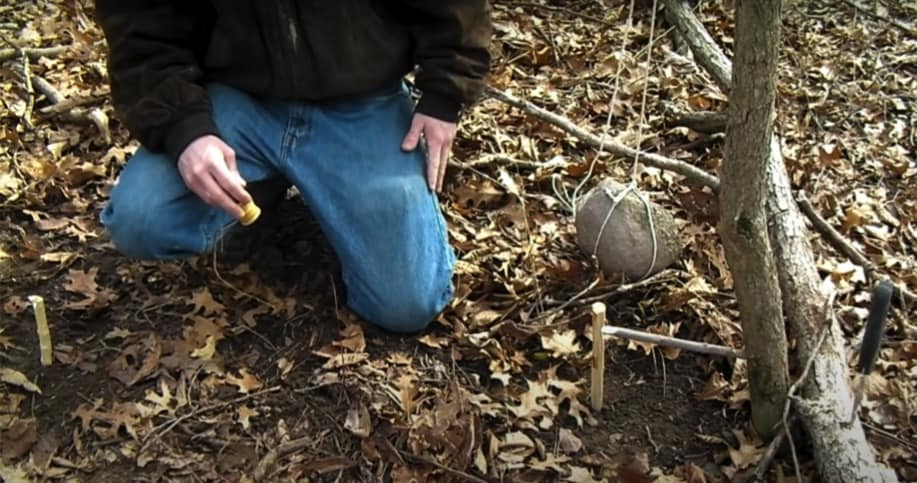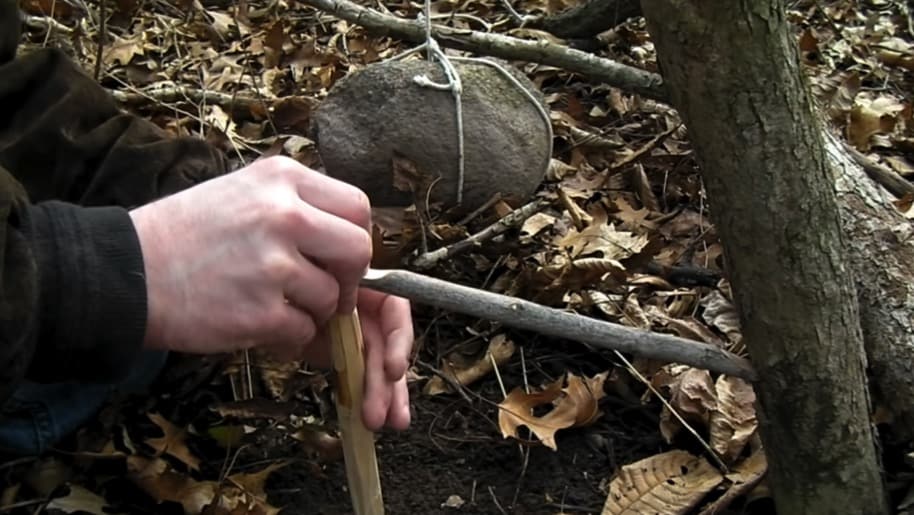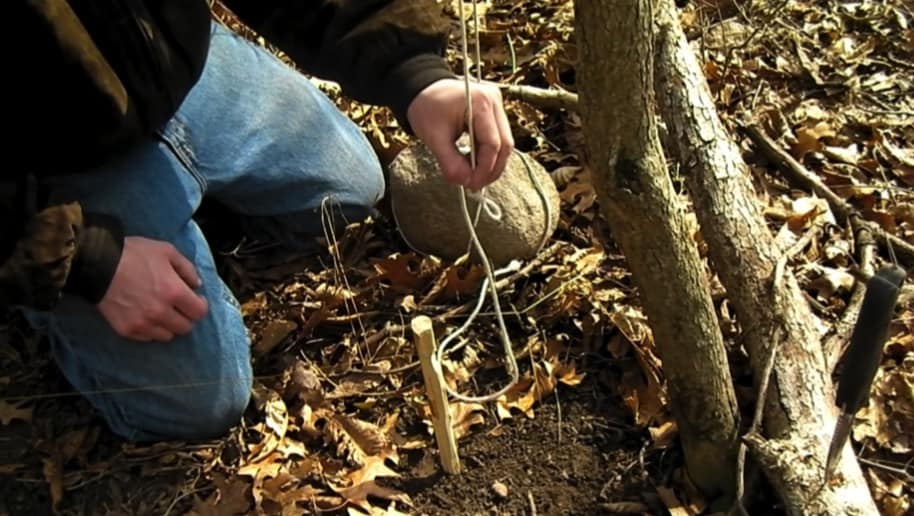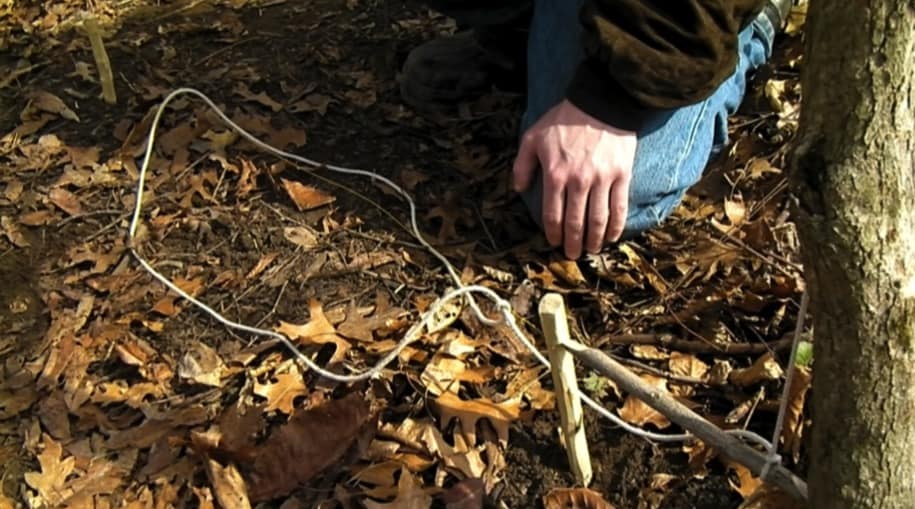
-
Save
Share this article: Bugoutbill.com is independent – we research, test, and rate the top products to help you make the right buying choice. We sometimes use affiliate links and may receive a small commission on your purchase. Learn more…
Overview
When out in the wild, you’ll be in situations where you’ll need to trap something (or someone) for survival.
The best way to do that is by tripwire hooks!
This is an essential skill to bring with you to your adventures. So in this article, we’d like to show you:
- The necessary materials and tools for making a tripwire hook;
- A step-by-step guide on how to make a tripwire hook;
- How to check if your trap works; and
- Many more!
Grab your go bag, buddy.
Time to get our hands dirty…
How to Make a Tripwire Hook in Survival Mode
Tripwire hooks are handmade traps for catching animals. But you can also use it to prevent intruders from entering your camp.
We’re telling you…
It’s a necessary skill because it would protect you from possible harm and provide you with food while in the wild. A lot of survivalists use this because of its subtlety and effectiveness.
But the best thing about tripwire hooks is that they’re simple and easy to make!
So, let’s start making it…
Table Of Contents
Table of Contents
Recent posts
Categories
Required Materials

-
Save
The first thing you need is a tripwire.
When you’re already in the wild, and you didn’t bring one, it might be difficult to find one sturdy enough. Dry twigs and used ropes might look promising, but they’re too weak to trip anything.
To ensure the effectiveness of your tripwire trap, it’s best to buy a line from your local hardware store. But you can also get this nice and durable one from this link.
A little note:
There are two common tripwire line colors. There’s the yellow wire and the green wire.
Yellow is best for areas where sunlight streams freely. It would prevent the wire from glinting and wouldn’t catch the eyes of your target.
On the other hand, the green one is best for shadowy places. For example, rainforests, intemperate mountains, your grassy backyard, etc. The line would then be camouflaged from your target’s sights.
Another thing you need is a rope.
You can use a manila rope or a polyester one. Just make sure that it’s thin enough to be almost invisible yet still sturdy and strong – like this survival cord.
You’ll need it to be durable because it’s the thing that would catch your game for you. And also…
It will hold another important material – the counterweight.
Counterweights should be at least 30 pounds heavy. The best thing to use is a rock because it won’t break easily when it falls.
And if it does break, there’s a lot of those where they came from. So, no regrets there.
Lastly, look for three light but sturdy sticks.
Thin, dry branches would work well – but not the decomposing ones.
The ones you need should be easily moved but could still stand when pinned on the soil. Once you find the right ones, cut them into about half a foot in length.
Narrow wooden planks will serve the same function if you can’t find sticks.
Now, your inventory is complete!
Tools
For this crafting process…
The only tool you need is a small knife.
That’s right!
It’s not rocket science. All you have to bring is a sharp tool for cutting wires, ropes, and thin wooden steaks – like a survival knife like this.
You may also use it for making notches – a crucial part of this step-by-step guide!
If you have your cutting tool, let’s get going!
Related: Survival Gear
How to Make a Tripwire Hook (Step-By-Step)

-
Save
Make The Platform
I like to start with setting up the sticks.
You’ll use one as the trigger and the other two for supporting the tripwire.
Get one support stick and use your cutting tool to make a notch – an inch from the tip. Then, sharpen the other tip so you can pin it into the ground.
Then…
Find a small, preferably young tree with a thin bark where you can set the tripwire hook on.
Make a shallow notch on the tree bark, the same height from the base as you made on your support stick.
Sharpen the tips of the other two sticks you have.
Once you’re done with that, you can pin those sticks to the ground.
Place the support stick from the tree bark so that the notches are facing each other. Their distance should be the length of your trigger stick. Make sure that the trigger fits snugly between the notches.
As for the last stick, you can place it at around three feet from the support.
Another note:
Don’t push the sticks too hard into the ground. They should still be loose enough to be uprooted at a slight movement.
Make The Tripwire Hook
It’s time to get your tripwire.
Run the tripwire between the support sticks. It’s best to put as much tension as possible so that the wire forms a straight line.
You can test if you did it right by tripping the wire. If the sticks fall, then you’re ready for the next step.

-
Save
Make The Game Catcher
Now, grab your rock and your rope.
Tightly tie the rope around the rock. Make sure it’s secured so that it won’t fall off even if you swing it.
Then, find a branch on your tree that’s about as high as four or five feet. Make your line go over the tree branch.
With the rock on the ground, pull the free end of the rope so that it forms a straight line from the counterweight, over the branch, and back to the ground. At about six inches from the branch, tie the rope tightly around your trigger stick.
Next, go to the loose end of the rope.
It’s time to make the loop!
Tie the rope end so that you can adjust the loop size. It’s called a noose knot or hangman’s knot – if you’re familiar with different ways to tie a line.
Just a reminder:
This will be your game catcher. So, when tightened, make sure that the loop or noose should be at least six inches above the floor (while the counterweight is on the ground.)
If the noose falls on the soil, you may catch an animal, but it could easily run off and escape. The goal here is to trap the target into hanging over the forest floor.
Complete the tripwire hook trap
Now, for the finishing touches.
Loosen up the noose – as wide as the length of the tripwire line. Then, place it right under the wire, between the support sticks.
And then, pull the trigger all the way down to the support stick and the base of the tree. Place the trigger snugly between the notches.
When done right…
The counterweight should be hanging from the branch. And the rope should be tight from the trigger up but loose from the trigger to the noose.

-
Save
Check If the Tripwire Hook Works
There’s no other way to test it but to trip the wire. So go ahead and look around for anything that could be the size and weight of an animal.
It could be old tree bark, a small rock, or one of your survival bags.
And throw it against the tripwire line!
It should trip the wire, pull the support sticks down, and release the trigger. Then the counterweight would fall to the ground, pulling the rope with it and tightening the noose around whatever tripped the wire.
Then your fake game would be hanging from the tree branch, about six inches above the ground.
If that happens – congratulations!
You just finished making your tripwire hook for survival!
Related: How To Make Char Cloth – & – How To Make Paracord Bracelet
Conclusion - How To Make A Tripwire Hook

-
Save
There’s another skill to add to your list!
Now, you can enjoy your outdoor adventure more, as you worry less about running out of food or possible camp intruders. You’ll have your handy tripwire to catch it for you!
So…
We’re not keeping you longer.
The game awaits you in the wild, buddy!
Similiar Posts
Community Cuisine: MREs and Grassroots Food Movement Engagement
Interested in the connection between community cuisine, MREs, and the grassroots food movement? This article
The Future of Food: MREs and Their Contribution to Systemic Change
Meal, Ready-to-Eat (MRE) is a convenient and portable food option that has been gaining popularity
On the Frontlines of Food Change: MREs in Food System Transformation
In a context where food system transformation is a prominent topic of discussion concerning sustainability

-
Save
About Author
Lorem Ipsum is simply dummy text of the printing and typesetting industry. Lorem Ipsum has been the industry's standard dummy text ever since the 1500s, when an unknown printer took a galley of type and scrambled it to make a type specimen book. It has survived not only five centuries, but also the leap into electronic typesetting, remaining essentially unchanged.
Author Name -

-
Save

